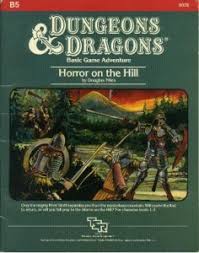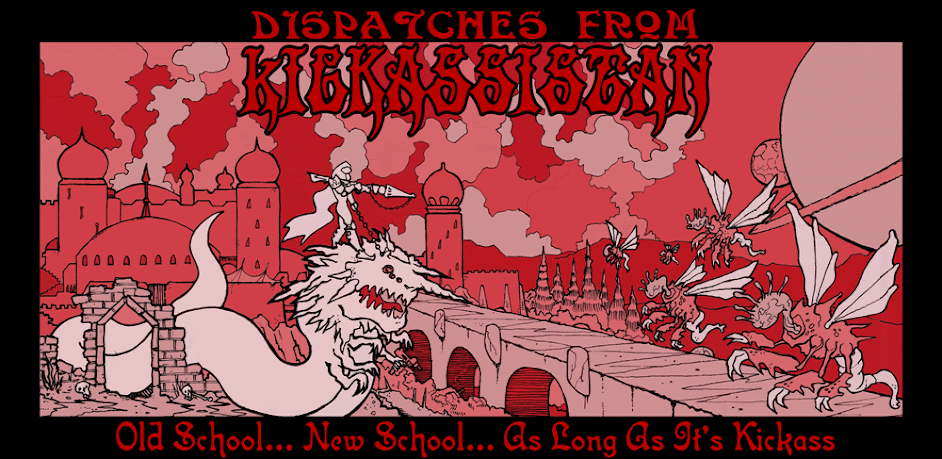If you've been following this blog for awhile, you're aware of the Keep on Kickassistan project I've been slowly working on for my Game of Taps DCC crew. The Game of Taps is the DCC campaign I run every other Monday night at the Taproom in downtown Ypsilanti, Michigan and the Keep on Kickassistan is the conversion of module B2: Keep on the Borderlands that I started running when we had some noteworthy absences from our gaming table. The Keep on Kickassistan has taken over our gaming group, primarily since it really supports the episodic "let's clear out this part of the dungeon then go back and spend our golds" mentality that playing every other week in a bar engenders.
Working on the Keep on Kickassistan has taught me a few fairly important lessons that I take with me every time I look at an old module with an eye toward how I'd run it. I spend a lot of time reading through old school modules, partially because they're the blueprint that we were given back in the day as to how to put an adventure together and partially because they give the reader a strong insight into the history of our hobby. If you look at the difference between the maps for B1 and B2, it's a stark, night and day difference showing how much evolution the hobby experienced in just a year (1978 for B1 and 1979/80 for B2).
 Right now, I'm reading through B5: Horror on the Hill, mostly because I recall +James Maliszewski writing about it back in November and then +James Raggi saying that he felt it was more deadly than his own modules (!!!), and am discovering that a lot of the problems that I have with prefab modules are infesting this module just like others. I was thinking about running this module at some point in the future as a FLAILSNAILS thing, so I've been looking at how to save this module from what I see as the pitfalls of blandness (by my sensibilities and aesthetics) and the tools that I'm using to save it are the same ones that I've been using for the Keep on Kickassistan.
Right now, I'm reading through B5: Horror on the Hill, mostly because I recall +James Maliszewski writing about it back in November and then +James Raggi saying that he felt it was more deadly than his own modules (!!!), and am discovering that a lot of the problems that I have with prefab modules are infesting this module just like others. I was thinking about running this module at some point in the future as a FLAILSNAILS thing, so I've been looking at how to save this module from what I see as the pitfalls of blandness (by my sensibilities and aesthetics) and the tools that I'm using to save it are the same ones that I've been using for the Keep on Kickassistan.
Here's what I see as the pitfalls of what I can only call "genre D&D" (the point at which D&D stops being a game that emulates a genre and starts being a genre in and of itself).
Working on the Keep on Kickassistan has taught me a few fairly important lessons that I take with me every time I look at an old module with an eye toward how I'd run it. I spend a lot of time reading through old school modules, partially because they're the blueprint that we were given back in the day as to how to put an adventure together and partially because they give the reader a strong insight into the history of our hobby. If you look at the difference between the maps for B1 and B2, it's a stark, night and day difference showing how much evolution the hobby experienced in just a year (1978 for B1 and 1979/80 for B2).
Here's what I see as the pitfalls of what I can only call "genre D&D" (the point at which D&D stops being a game that emulates a genre and starts being a genre in and of itself).
- Not Another Orc Syndrome: Genre D&D is plagued by 10 x 10 room after 10 x 10 room filled with goblins, kobolds, orcs and a host of other generic enemies that once, back in the day, felt new and exciting. Today, the genre of D&D has forced so many of these goblin rooms on us that I can't see a single one of them being interesting or worth running on their own. Ever wonder why 4e is so focused on the "setpiece encounter?" I'd say it stems from the Not Another Orc Syndrome and wanting to make goblin rooms actually enjoyable.
- 2KCP: That's my hip and happening way of writing "2000 copper pieces;" like it? The 2KCP issue has become a huge one lately, primarily due to the efforts of +Erik Tenkar & +Joe D illustrating how ridiculous and non-versimilitudinous it is that a room of giant rats might be guarding exactly two thousand copper pieces. Completely round denominations like 2KCP never made any sense to me and always seemed to be lazy bookkeeping on the part of adventure designers. How exactly am I supposed to believe that my cleric just found exactly 2000 cp in a rats' nest?
- Two Great Tastes That Taste Terrible Together: So, this problem is a little more abstract and might not make sense with me just talking about it. I think this is more of a phenomenological problem that you have to experience to understand. That having been said, the Two Great Tastes problem is where broadly clashing genre elements are placed side by side in a horrific juxtaposition that defies logic and often serves to cartoonify and parody more serious genre elements. Two Great Tastes becomes a problem when clashing elements are used in a serious game or without regard to aesthetic as they often are in genre D&D. For an example of the Two Great Tastes problem, look at Holloway's illustration of the witches from Horror on the Hill (page 8): these are not the twisted and warped swamp hags that I'd expect from a grim tale of swords & sorcery (with a legacy of deadliness that makes James Raggi consider it more deadly than even his own Death Frost Doom), but rather friendly and not-at-all-sinister grandmas built on the Aunt Bea model. One of these things is not like the others, one of these things just doesn't belong. Except in Wampus Country.
- +1 Longsword, +2 Plate Mail: I'm not the kind of DM who enjoys handing out magic items willy-nilly. When I hand out a magic item, two things are certain: the player earned that magic item and the item is unique. If it's a weapon, it probably has a name and likely some sort of personality. If it's armor, it likely has a legacy and was made for someone important (though probably long-dead), although you can't rule out names and personalities. Other items are case-by-case things so that everything feels unique and special. There are no magic item factories churning out shields +1 or wizard academies that sell off the by-product swords +1 from their Enchanting 101 classes. Stuff like that just bores me to tears (however much some players might like it) and always has. Finding a dagger +1 in some ancient and dusty hallway or in the hoard of some carrion beast or another just feels uninteresting to me and, I feel, sells the players and your joint story short when it comes to meaningful additions to your game.
I'm sure there are other problems that old modules have, and that there are many people who don't consider the problems that I identify here as actually being problems. I mean hey, some people actually enjoy drinking Budweiser (or rather, I assume they do), but not me. For my tastes, sensibilities and aesthetics -- as well as the expectations of my players -- these four areas need to be altered in order to "save" genre D&D modules from their genre identity and make them enjoyable again and the beer needs to be something far more tastier than Budweiser. As I start getting ready to strip down Horror on the Hill into something usable -- and continue to do the same with Keep on the Borderlands -- I'll try to let you know how I'm dealing with the specific challenges that these problems introduce into my game.
